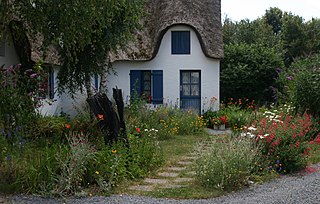
A wildlife garden is an environment created by a gardener that serves as a sustainable haven for surrounding wildlife. Wildlife gardens contain a variety of habitats that cater to native and local plants, birds, amphibians, reptiles, insects, mammals and so on. Establishing a garden that emulates the environment before the residence was built and/or renders the garden similar to intact wild areas nearby (rewilding) will allow natural systems to interact and establish an equilibrium, ultimately minimizing the need for gardener maintenance and intervention. Wildlife gardens can also play an essential role in biological pest control, and also promote biodiversity, native plantings, and generally benefit the wider environment.

An alvar is a biological environment based on a limestone plain with thin or no soil and, as a result, sparse grassland vegetation. Often flooded in the spring, and affected by drought in midsummer, alvars support a distinctive group of prairie-like plants. Most alvars occur either in northern Europe or around the Great Lakes in North America. This stressed habitat supports a community of rare plants and animals, including species more commonly found on prairie grasslands. Lichen and mosses are common species. Trees and bushes are absent or severely stunted.

Helianthus is a genus comprising about 70 species of annual and perennial flowering plants in the daisy family Asteraceae. Except for three South American species, the species of Helianthus are native to North America and Central America. The common names "sunflower" and "common sunflower" typically refer to the popular annual species Helianthus annuus, whose round flower heads in combination with the ligules look like the sun. This and other species, notably Jerusalem artichoke, are cultivated in temperate regions and some tropical regions as food crops for humans, cattle, and poultry, and as ornamental plants. The species H. annuus typically grows during the summer and into early fall, with the peak growth season being mid-summer.

Jasione montana is a low-growing plant in the family Campanulaceae found in rocky places and upland regions of Europe and western Asia. Common names include sheep's-bit, blue bonnets, blue buttons, blue daisy and iron flower. Due to the similarity of the common name of "sheep's-bit" with that of devil's-bit scabious, it is sometimes called "sheep's-bit scabious" or "sheep scabious", but it is not related to the scabiouses.

Echinacea laevigata, the smooth purple coneflower, is an Endangered Species Act federally listed endangered species of plant found in the piedmont of the eastern United States. Most populations are found on roadsides and other open areas with plenty of sunlight, often on calcium- and magnesium- rich soils.

Solidago shortii, commonly known as Short's goldenrod, is a species of goldenrod in the sunflower family. The only known populations of Short's goldenrod occur around the Blue Licks Battlefield State Park area of Kentucky and Harrison-Crawford State Forest in Indiana. It was listed on the Federal Register of Endangered Species on September 5, 1985, and was given a global rank of G1 on February 29, 2000.

Erigeron annuus, the annual fleabane, daisy fleabane, or eastern daisy fleabane, is a species of herbaceous, annual or biennial flowering plant in the daisy family Asteraceae.

Astragalus phoenix is a rare species of milkvetch known by the common name Ash Meadows milkvetch. It is endemic to Nye County, in southwestern Nevada.

Castilleja levisecta is a rare species of flowering plant in the family Orobanchaceae known by the common name golden paintbrush, or golden Indian paintbrush, listed under the Endangered Species Act in 1997. It is native to British Columbia and Washington, where it is known from eleven remaining populations. It occurred in Oregon but all natural occurrences there have been extirpated. It has been reintroduced to a few areas in Oregon, but it remains to be seen if the plants will survive. The plant is a federally listed endangered species of Canada and was listed as threatened in the United States in 1997. On June 30, 2021, the plant was proposed for delisting due to recovery.
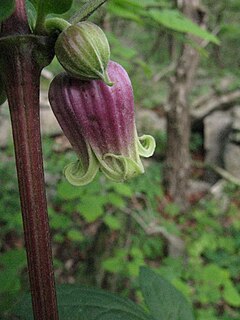
Clematis morefieldii is a rare species of flowering plant in the buttercup family known by the common names Morefield's leather flower and Huntsville vasevine.

Clematis socialis is a rare species of flowering plant in the buttercup family known by the common name Alabama leather flower. It is native to the US states of Alabama and Georgia, where it is known from only five populations. The species is seriously threatened by habitat destruction. It is a federally listed endangered species.

Deinandra conjugens is a rare species of flowering plant in the aster family known by the common names Otay tarplant and Otay tarweed. It is native to a small section of far northern Baja California in Mexico, its range extending north into San Diego County, California, in the United States. One isolated population has been reported from the hills east of Cayucos in San Luis Obispo County.

Polygala lewtonii is a rare species of flowering plant in the milkwort family known by the common name Lewton's polygala, or Lewton's milkwort. It is endemic to Florida in the United States, where it is limited to the central ridge of the peninsula. There are about 49 occurrences of the plant remaining. Most occurrences contain very few plants. The species is threatened by the loss and degradation of its habitat. This is a federally listed endangered species of the United States.
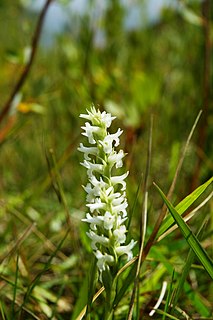
Spiranthes diluvialis is a rare species of orchid known as Ute lady's tresses. The species name diluvialis means "of the flood". It is native to the western United States, where there are scattered, mostly small occurrences in the states of Colorado, Idaho, Montana, Nebraska, Nevada, Utah, Washington, and Wyoming. An occurrence was recently discovered in southern British Columbia. The plant faces a number of threats to its existence. It is a federally listed threatened species of the United States.
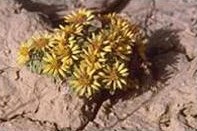
Townsendia aprica is a rare species of flowering plant in the aster family known by the common name Last Chance Townsend daisy. It is endemic to Utah in the United States, where it is known from three counties. It faces a number of threats and it is a federally listed threatened species of the United States.

Erigeron maguirei is a species of flowering plant in the aster family known by the common names Maguire daisy and Maguire's fleabane. It is endemic to Utah in the United States. It is a perennial herb growing up to 28 centimetres tall. It grows from a taproot and a branching caudex. The stems are densely hairy. The inflorescence holds one to five flower heads each with several hairy, glandular phyllaries. The head has up to 20 white, pink-tinged, or pink ray florets 0.6 to 0.8 centimeters long, and many yellow disc florets at the center.

Eucephalus vialis is a rare North American species of flowering plant in the aster family known by the common name wayside aster. It is native to southwestern Oregon and northwestern California in the United States.

Symphyotrichum georgianum is a rare species of flowering plant in the Asteraceae, the aster family. Its common name is Georgia aster. It is native to the southeastern United States where it is known from Alabama, Florida, Georgia, North Carolina, and South Carolina. As of 2013, it may be extirpated from the state of Florida.
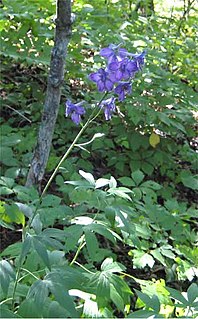
Delphinium exaltatum, known by the common name tall larkspur, is a species of flowering plant in the genus Delphinium, part of the buttercup family. Other Delphinium species are also commonly known as tall larkspur, such as Delphinium barbeyi. D. exaltatum is native to the central and eastern United States, where it can be found in Kentucky, Maine, Ohio, Pennsylvania, Maryland, West Virginia, Virginia, North Carolina, Alabama, Tennessee, and Missouri.

Protea pruinosa, also known as frosted sugarbush or burnished protea, is a flowering shrub which belongs to the genus Protea within the botanical family Proteaceae. The plant is endemic to the southwestern Cape Region of South Africa.
























